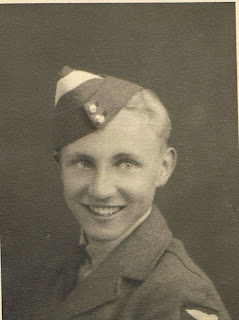 |
| W/O Pete Godfrey (author's collection) |
As we approach 11th November, thoughts turn to those who gave their lives in service of their country during two World Wars as well as numerous other conflicts including those who serve in Afghanistan during the present day.
In one of the earliest posts on this blog, in The Dreaded Telegram we examined the story behind one of the names on a memorial plaque to be found at Ickenham Cricket Club in Middlesex. The sort of plaque that we have at Ickenham can be mirrored at countless cricket, rugby, football and other sports clubs across the country, as well as schools and other institutions, commemorating their members, former pupils and employees who made the ultimate sacrifice. At the time of this earlier post, we undertook to look at another of those commemorated and with Remembrance Day fast approaching, perhaps now is the time to do this.
Peter Leopold Godfrey, inevitably known as 'Pete' to his friends and squadron colleagues, was a twenty one year old Warrant Officer Pilot in the Royal Air Force. The photograph of him shows him to be a fresh faced young man and to look at his image is an instant reminder as to the extreme youth of the majority of those men fighting in the front line, whether they be soldiers, sailors or airmen. Pete was from Ickenham, which seventy years ago was even more of an outer suburb of London than it is today. He was educated at Harrow County School for Boys at nearby Harrow on the Hill and by all accounts was a fine young man as well as an excellent sportsman, joining his local cricket club at Ickenham, where he was described as an outstandingly good wicket keeper.
 |
| Ickenham Cricket Club Memorial Plaque (author's photo) |
Pete would have been too young to have joined up on the outbreak of war in 1939, but by 1941 he had joined the RAF and after his pilot training he joined 80 Squadron, at that time based in North Africa as part of the Desert Air Force but later to move to Italy, before returning to the UK in April 1944 in preparation for Operation Overlord, at which time the squadron re-equipped with the Spitfire Mk IX fighter. In September 1944, the squadron once again re-equipped, this time with the Hawker Tempest Mk V, one of the fastest piston-engined fighters, which apart from their ground attack role in support of the Allied armies then involved in liberating France and the Low Countries from Nazi domination, were also instrumental in bringing down the V-1 Flying Bombs then plagueing London and Southeast England.
There was another task in hand for the new Tempest fighters in September 1944; on September 17th, Operation 'Market Garden' was launched. This was Field Marshal Montgomery's audacious attempt to end the war early by advancing into Northern Germany by taking the bridges over the Rivers Waal and Neder Rhine and which was to culminate in the glorious failure at Arnhem.
All of this heartbreak was in the future when 80 Squadron took off from it's base at RAF Manston at 11:30 on the 17th September, tasked with flak-suppression duties over the Walcheren and Schouwen Islands. The squadron's War Diary laconically records that "Several guns were silenced.....One armed barge was attacked and left burning, whilst four others were damaged." The diary then goes on to record that "Flak was plentiful and Tempest EJ519 piloted by W/O P.L. (Pete) Godfrey was hit. He was not seen to bale out and aircraft was seen to crash into the sea."
 |
| A 'sister' Hawker Tempest EJ705 of 80 Squadron (www.hawkertempest.se) |
Thus was the end of Pete Godfrey's life recorded in the unemotional language of the Squadron War Diary. Probably a glass or two would have been raised in his memory at a suitable time by his mates from the squadron and no doubt, his commanding officer would have had the heartbreaking task of writing to Pete's parents back home in Ickenham to break the awful news that they would never see their son again. It would have been a sad fact of life that this would have been a task that Pete's C.O. would have become used to performing, although it would never have been an easy or pleasant task, not eased by repetition.
For his squadron mates, it was business as usual; after returning to Manston at 13:35 to re-arm and refuel, 80 Squadron took off again at 18:25 and an armed recce of the Hague - Wassenaar - Leiden - Katwyk area was carried out, with further strikes being made on barges, motor transport and a car. Considerable light anti-aircraft fire was encountered but this time, the squadron incurred no losses and returned to base at 20:10. The squadron was to continue on these duties for the duration of 'Market Garden', an operation which was to end in failure at 'A Bridge too Far' in Arnhem and from whence a handful of bedraggled and bloodied British and Polish Airborne survivors were extricated some nine days later, whilst many more survivors were to become Prisoners of War and still more were never to return home.
Back home in England, Pete Godfrey's parents, along with the parents, wives, girlfriends and loved ones of many others would be beginning to try to come to terms with their loss.
Many families throughout Britain, the Commonwealth, the USA and indeed the whole World would have shared the experiences of Pete Godfrey's parents.
Remember them all.
Published Sources:
A Bridge Too Far - Cornelius Ryan, Wordsworth 1999
Arnhem: The Battle for Survival - John Nichol and Tony Rennell, Penguin 2012
Unpublished Sources:
80 Squadron War Diary - National Archives, Kew

No comments:
Post a Comment